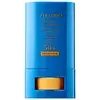What's inside
What's inside
 Key Ingredients
Key Ingredients

 Benefits
Benefits

 Concerns
Concerns

 Ingredients Side-by-side
Ingredients Side-by-side

Water
Skin ConditioningDiisopropyl Sebacate
EmollientZinc Oxide
Cosmetic ColorantAlcohol
AntimicrobialEthylhexyl Methoxycinnamate
UV AbsorberButylene Glycol
HumectantTranexamic Acid
AstringentBis-Ethylhexyloxyphenol Methoxyphenyl Triazine
Skin ConditioningDiethylamino Hydroxybenzoyl Hexyl Benzoate
UV FilterDimethicone
EmollientHydrated Silica
AbrasiveGlycerin
HumectantEthylhexyl Triazone
UV AbsorberPEG-60 Hydrogenated Castor Oil
EmulsifyingPhenoxyethanol
PreservativePEG-12 Dimethicone
Skin ConditioningDimethylacrylamide/Sodium Acryloyldimethyltaurate Crosspolymer
Isostearic Acid
CleansingParfum
MaskingBHT
AntioxidantSuccinoglycan
Skin ConditioningHydroxypropyl Methylcellulose Stearoxy Ether
Camellia Sinensis Extract
AntioxidantLeontopodium Alpinum Extract
Skin ConditioningPrunus Speciosa Leaf Extract
Skin ConditioningTocopheryl Acetate
AntioxidantSorbitan Sesquiisostearate
EmulsifyingSucrose Tetrastearate Triacetate
EmollientSodium Acetylated Hyaluronate
HumectantPotentilla Erecta Root Extract
Skin ConditioningAloe Barbadensis Leaf Extract
EmollientSoluble Collagen
HumectantWater, Diisopropyl Sebacate, Zinc Oxide, Alcohol, Ethylhexyl Methoxycinnamate, Butylene Glycol, Tranexamic Acid, Bis-Ethylhexyloxyphenol Methoxyphenyl Triazine, Diethylamino Hydroxybenzoyl Hexyl Benzoate, Dimethicone, Hydrated Silica, Glycerin, Ethylhexyl Triazone, PEG-60 Hydrogenated Castor Oil, Phenoxyethanol, PEG-12 Dimethicone, Dimethylacrylamide/Sodium Acryloyldimethyltaurate Crosspolymer, Isostearic Acid, Parfum, BHT, Succinoglycan, Hydroxypropyl Methylcellulose Stearoxy Ether, Camellia Sinensis Extract, Leontopodium Alpinum Extract, Prunus Speciosa Leaf Extract, Tocopheryl Acetate, Sorbitan Sesquiisostearate, Sucrose Tetrastearate Triacetate, Sodium Acetylated Hyaluronate, Potentilla Erecta Root Extract, Aloe Barbadensis Leaf Extract, Soluble Collagen
Butyl Methoxydibenzoylmethane 2.5%
UV AbsorberHomosalate 10%
Skin ConditioningEthylhexyl Methoxycinnamate 4.9%
UV AbsorberEthylhexyl Salicylate 5%
UV AbsorberOctocrylene 5%
UV AbsorberBenzophenone-3 3%
UV AbsorberDiphenylsiloxy Phenyl Trimethicone
Skin ConditioningTriethylhexanoin
MaskingParaffinum Liquidum
EmollientHydroxystearic Acid
CleansingDibutyl Lauroyl Glutamide
Skin ConditioningPolyamide-8
EmollientPEG/PPG-14/7 Dimethyl Ether
Skin ConditioningLecithin
EmollientGlycyrrhiza Glabra Root Extract
BleachingPPG-17
Skin ConditioningSilica Dimethyl Silylate
EmollientBHT
AntioxidantTocopherol
AntioxidantPentaerythrityl Tetra-Di-T-Butyl Hydroxyhydrocinnamate
AntioxidantParfum
MaskingButyl Methoxydibenzoylmethane 2.5%, Homosalate 10%, Ethylhexyl Methoxycinnamate 4.9%, Ethylhexyl Salicylate 5%, Octocrylene 5%, Benzophenone-3 3%, Diphenylsiloxy Phenyl Trimethicone, Triethylhexanoin, Paraffinum Liquidum, Hydroxystearic Acid, Dibutyl Lauroyl Glutamide, Polyamide-8, PEG/PPG-14/7 Dimethyl Ether, Lecithin, Glycyrrhiza Glabra Root Extract, PPG-17, Silica Dimethyl Silylate, BHT, Tocopherol, Pentaerythrityl Tetra-Di-T-Butyl Hydroxyhydrocinnamate, Parfum
 Reviews
Reviews

Ingredients Explained
These ingredients are found in both products.
Ingredients higher up in an ingredient list are typically present in a larger amount.
BHT is a synthetic antioxidant and preservative.
As an antioxidant, it helps your body fight off free-radicals. Free-radicals are molecules that may damage your skin cells.
As a preservative, it is used to stabilize products and prevent them from degrading. Specifically, BHT prevents degradation from oxidation.
The concerns related to BHT come from oral studies; this ingredient is currently allowed for use by both the FDA and EU.
However, it was recently restricted for use in the UK as of April 2024.
Learn more about BHTEthylhexyl Methoxycinnamate is an organic compound that provides UVB protection. It often goes by the more common name of octinoxate. It is created from methoxycinnamic acid and 2-ethylhexanol.
Ethylhexyl Methoxycinnamate absorbs UVB rays with wavelengths between 280-320 nm. UV absorbers protect your skin by using chemical reactions to convert UV rays into heat and energy.
UVB (290-320 nm) rays emit more energy than UVA rays. They are capable of damaging DNA, causing sunburns and are thought to be linked to skin cancer.
The state of Hawaii has banned sunscreens containing octinoxate due to its potential impact on coral reefs. More research is needed to bridge gaps in this research. The European Union allows higher levels of octinoxate in sunscreens than the US and Australia.
Ethylhexyl Methoxycinnamate is oil soluble. It is not stable and may lose efficacy when exposed to sunlight.
Learn more about Ethylhexyl MethoxycinnamateParfum is a catch-all term for an ingredient or more that is used to give a scent to products.
Also called "fragrance", this ingredient can be a blend of hundreds of chemicals or plant oils. This means every product with "fragrance" or "parfum" in the ingredients list is a different mixture.
For instance, Habanolide is a proprietary trade name for a specific aroma chemical. When used as a fragrance ingredient in cosmetics, most aroma chemicals fall under the broad labeling category of “FRAGRANCE” or “PARFUM” according to EU and US regulations.
The term 'parfum' or 'fragrance' is not regulated in many countries. In many cases, it is up to the brand to define this term.
For instance, many brands choose to label themselves as "fragrance-free" because they are not using synthetic fragrances. However, their products may still contain ingredients such as essential oils that are considered a fragrance by INCI standards.
One example is Calendula flower extract. Calendula is an essential oil that still imparts a scent or 'fragrance'.
Depending on the blend, the ingredients in the mixture can cause allergies and sensitivities on the skin. Some ingredients that are known EU allergens include linalool and citronellol.
Parfum can also be used to mask or cover an unpleasant scent.
The bottom line is: not all fragrances/parfum/ingredients are created equally. If you are worried about fragrances, we recommend taking a closer look at an ingredient. And of course, we always recommend speaking with a professional.
Learn more about Parfum